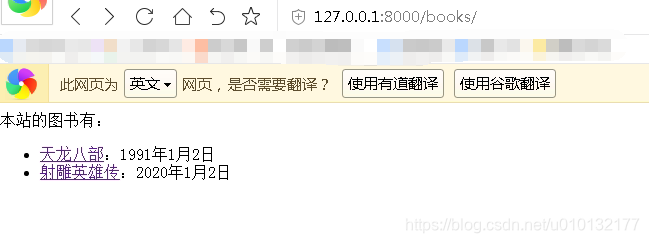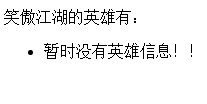一、从数据库读取图书数据并渲染出来
1)app1/views.py函数books编写
【1】从模型下导入bookinfo信息
【2】从数据库获取图书对象列表
【3】把获取到的图书对象赋值给books键。【注意】键'books'必须要加引号
from django.shortcuts import render
from app1.models import BookInfo #【1】从模型下导入bookinfo信息
# app1应用首页
def index(request):
context={} #定义1个字典
context['hello']='hello world!!!' #向字典写一个键:值(hello:'hello world!!')
context['wa']='wawawawawahahahaha!'
context['list']=list(range(1,10)) #定义一个字典值为一个列表,list为把内容转换为列表
return render(request,'app1/index.html',context) #返回:把context渲染到app1/index.html的模板文件
# app1应用图书页
def books(request):
books=BookInfo.objects.all()#【2】从数据库获取图书对象列表
return render(request,'app1/book.html',{'books':books})#【3】把获取到的图书对象赋值给books键。【注意】键'books'必须要加引号
2)app1/urls.py配置
【1】引入views
【2】books应用配置
from django.urls import path
from . import views #【1】引入views
urlpatterns=[
path('app1/',views.index),
path('books/',views.books),#【2】books应用配置
]
3)templates/app1/book.html模析创建编写
<!DOCTYPE html>
<html lang="en">
<head>
<meta charset="UTF-8">
<title>书籍页面</title>
</head>
<body>
本站的图书有:
<ul>
{% for book in books %}
<li>{{book.btitle}}:{{book.bpub_date}}</li>
{%empty%}
暂时没有图书!!!
{% endfor %}
</ul>
</body>
</html>
效果:http://127.0.0.1:8000/books/
本站的图书有:
天龙八部:1991年1月2日
射雕英雄传:2020年1月2日
二、通过url传参,访问书英雄详情
1)加带参数的链接/templates/app1/book.html
【1】通过href属性,把book的id做为参数传给详情页,进而查询对应英雄信息
<!DOCTYPE html>
<html lang="en">
<head>
<meta charset="UTF-8">
<title>书籍页面</title>
</head>
<body>
本站的图书有:
<ul>
{% for book in books %}
<!--【1】通过href属性,把book的id做为参数传给详情页,进而查询对应英雄信息-->
<li><a href="/detail/{{book.id}}"> {{book.btitle}}</a>:{{book.bpub_date}}</li>
{%empty%}
暂时没有图书!!!
{% endfor %}
</ul>
</body>
</html>
2)接收参数,渲染到模板app1/views.py
【1】查询主键为url中传过来的参数Id。或写成:id=bookId
【2】关联查询:查询对应书的所有英雄信息
【3】把参数渲染到detail页面去
from django.shortcuts import render
from app1.models import BookInfo #【0】从模型下导入bookinfo数据模型
def index(request):
'''app1应用:首页'''
context={} #定义1个字典
context['hello']='hello world!!!' #向字典写一个键:值(hello:'hello world!!')
context['wa']='wawawawawahahahaha!'
context['list']=list(range(1,10)) #定义一个字典值为一个列表,list为把内容转换为列表
return render(request,'app1/index.html',context) #返回:把context渲染到app1/index.html的模板文件
def books(request):
'''app1应用:图书列表页'''
books=BookInfo.objects.all()#从数据库获取图书对象列表
return render(request,'app1/book.html',{'books':books})#把获取到的图书对象赋值给books键。【注意】键'books'必须要加引号
def detail(request,bookId):# bookId为接收urls.py中指定的参数,来源页templates/app1/book.html
'''app1应用:图书详情页,显示英雄信息'''
book=BookInfo.objects.get(pk=bookId) #【1】查询主键为url中传过来的参数Id。或写成:id=bookId
heros=book.heroinfo_set.all() #【2】关联查询:查询对应书的所有英雄信息
return render(request,'app1/detail.html',{'book':book,'heros':heros}) #【3】把参数渲染到detail页面去
3) 配置url及传参形式 app1/urls.py
【书详情页】,通过url接收参数2种写法以下两种都可
from django.urls import path,re_path
from . import views
urlpatterns=[
path('app1/',views.index),
path('books/',views.books),
# 【书详情页】,通过url接收参数2种写法以下两种都可:
# path(r"detail/<int:bookId>",views.detail), #参数用尖括号包起来<>
re_path(r"^detail/(d+)",views.detail), #参数必须要带括号
]
4)详情模板 templates/app1/detail.html
【1】如果数据为空则执行如下代码
<!DOCTYPE html>
<html lang="en">
<head>
<meta charset="UTF-8">
<title>图书详情页,英雄信息</title>
</head>
<body>
{{book.btitle}}的英雄有:
<ul>
{% for hero in heros %}
<li>{{hero.hname}}:{{hero.hcomment}}</li>
{%empty%}<!--【1】如果数据为空则执行如下代码-->
<li>暂时没有英雄信息!!</li>
{% endfor %}
</ul>
</body>
</html>
5.附件)project1/models.py
表来源此处
from django.db import models
# 设计和表对应的类,模型类
# 一类
# 图书类
class BookInfo(models.Model):
'''图书模型类'''
# 图书名称,CharField说明是一个字符串,max_length指定字符串的最大长度
btitle = models.CharField(max_length=20)
# 出版日期,DateField说明是一个日期类型
bpub_date = models.DateField()
def __str__(self): #重定义系统的str方法,让它返回对应图书的名字
return self.btitle
# 多类
# 英雄人物类
# 英雄名 hname
# 性别 hgender
# 年龄 hage
# 备注 hcomment
# 关系属性 hbook,建立图书类和英雄人物类之间的一对多关系
class HeroInfo(models.Model):
'''英雄人物模型类'''
hname = models.CharField(max_length=20) # 英雄名称
# 性别,BooleanField说明是bool类型,default指定默认值,False代表男
hgender = models.BooleanField(default=False)
# 备注
hcomment = models.CharField(max_length=128)
# 关系属性 hbook,建立图书类和英雄人物类之间的一对多关系
# 关系属性对应的表的字段名格式: 关系属性名_id
hbook = models.ForeignKey('BookInfo', on_delete=models.CASCADE) #对应BookInfo表的主键ID
def __str__(self): #返回英雄名
return self.hname
效果:点书列表 http://127.0.0.1:8000/books/

进入英雄详情:http://127.0.0.1:8000/detail/3

英雄为空,在localhost:8000/admin新加一个书《笑傲江湖》,但不要加英雄信息,book页再点进去后:http://127.0.0.1:8000/detail/4
